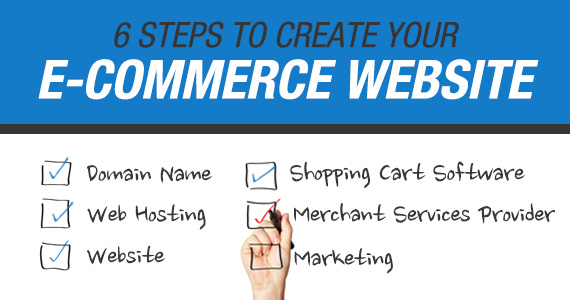 You’ve decided what to sell and have already weighed the pros and cons of using an online marketplace option vs. creating your own website. Now it’s time to create your e-commerce website. It’s a daunting task for many, so read on for 6 steps to put you well on your way to selling online sooner than later.
You’ve decided what to sell and have already weighed the pros and cons of using an online marketplace option vs. creating your own website. Now it’s time to create your e-commerce website. It’s a daunting task for many, so read on for 6 steps to put you well on your way to selling online sooner than later.
- Decide on a domain name, and secure it for your site. A domain name is the online address for your site. Having your domain name match your business’ name as closely as possible makes it easy for shoppers to find you. Keep in mind that the maximum character count for domain names is 63, and shorter is easier for visitors to remember too. Remember it’s possible that your first choice URL has already been secured by another user, so explore your options (for example, if “wendysjewelry” is already taken, you can try something similar like “wendysjewelryonline”). A .com suffix is usually preferable, however, and try to avoid using special characters like hyphens and underscore bars, which are hard to communicate verbally. Once you have decided on the perfect URL, register the name with an accredited domain name registrar, such as godaddy.com, register.com or hostgator.com.
- Figure out who will host your site. Your Web host publishes the site online (making it “live”). The host stores data files and uploads them to the Web for viewing. The host also usually offers valuable security features, such as secure servers that guard against cybercriminal activity, malware and viruses. In addition, the web host serves as your small business’ IT team, helping you get up and running and troubleshooting any technical issues.
- Create your site. Put some thought into the functionality and design of your site. Remember, this is your store’s online home! You want to encourage shoppers to browse, and make it easy for them to make purchases. Don’t forget good photography, information about you and your products, deals you’re offering, and links to your social media pages.
- Set up your shopping cart. Your shopping cart needs may vary depending on what you’re selling. For example, is your stock limited to single items, or are there options for size and color? The goal is to make it easy for shoppers check out in as few steps as possible. Popular cart services include 3dcart and Zen Cart, but there are many others, and many include tools like setup and template services as well as tailored plans. Finally, if you plan to offer discounts, be sure to use a system that makes adding elements like coupons easy.
- Choose a merchant services provider. PayPal is the most familiar name to sellers and shoppers alike, and it’s simple to get started. But Google Checkout and Amazon Payments are increasingly popular choices as well. If you would prefer to accept credit-card payments directly, you’ll need an Internet Merchant Account to process payments directly.
- Market your site. Now that all the back-end is in place, it’s time to bring customers to your e-commerce store. Make sure to search engine optimization (SEO) and pay-per-click (PPC) advertising, and don’t forget social media! Set up and link to your business page on Facebook and check out our tips on email marketing and blogging to attract visitors.
And Don’t Forget …
- E-commerce software keeps your operations streamlined. A “one-stop shop” for getting up and running, e-commerce software will walk you through every step of the setup process, from domain name to payment options. The monthly fee – ranging from $15 to more than $300 – can be well worth it if it keeps your focus on your products and marketing. Popular e-commerce software options are Volusion, Shopify and Shopping Cart Elite.
- Third-party sites can get you started faster. If you aren’t quite ready to set up your own site, get your feet wet with large marketplaces such as eBay and Amazon. Using their services to start may give you the push you need to establish a site of your own.
The Bottom Line
You’re spending time making the best decisions for you and your e-commerce site, which will pay off once your site goes live. Carefully consider your website options and the steps needed to establish the right storefront for your business goals, and before long you’ll be up, running … and selling!






